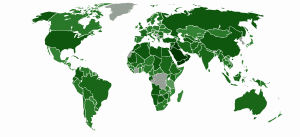- Military budget
-
A military budget of an entity, most often a nation or a state, is the budget and financial resources dedicated to raising and maintaining armed forces for that entity. Military budgets reflect how much an entity perceives the likelihood of threats against it, or the amount of aggression it wishes to employ. It also provides an idea of how much finances could be provided for the upcoming year.
Generally excluded expenditures are:
- Internal law enforcement
- Disabled veteran rehabilitation
The Stockholm International Peace Research Institute estimates that in 2007 military expenditures for the world were $1,339,000,000,000.
Contents
Military budgets (1897)
In the Saturday Review magazine in February 1898, indicates that the percentage of tax revenue spent on military budgets as follows:
- United States: 17%
- Russian Empire: 21%
- France: 27%
- United Kingdom : 39%, 40 million pounds or 2.5% of GNP.
- German Empire: 43%
- Empire of Japan: 55%, 132 millions of yens.
Military budgets (2003)
The yearly report from the Stockholm International Peace Research Institute shows that the purchase of military products by NATO member nations during the year 2003 rose 11 percent relative to 2002 (6.5 percent in volume). In some countries, this budget has been increased to the level maintained during the Cold War.
The military budget of the United States leads in this increase; U.S. purchases account for 47 percent of world military expenditures in 2003, which totaled about US$956 billion. The funds for the War in Iraq and the supplementary expense of US$83 billion account for much of this increase; other spending only accounts for 3.5 percent of the increase.
The US spends almost as much money on defence as all the other countries in the world combined.
The military budgets of the United Kingdom, France, Germany and Italy represent about 15 percent (US$120 billion) of world military spending.[1] France and the United Kingdom have increased their equipment expenses, not only to act in United States military operations with the same technological level of their ally, but equally to be able to act independently in smaller military campaigns such as in Libya.
Among non-NATO nations, Japan spent US$46.9 billion on military resources in 2003, The People's Republic of China, US$32.8 billion, and Russia, US$13 billion, (5 percent, 4 percent, and 1 percent of the world total, respectively).
Further information: Military budget of the United States, Military budget of the People's Republic of China, and Defense budget of JapanNATO countries' largest military budgets
Budgets 2010 for NATO countries in billions of US dollars
Country Budget
(in Billions)United States of America 698.000[2] United Kingdom 59.642 France 59.354 Germany 45.248 Italy 38.198 Canada 20.164 Spain 15.803 Turkey 15.634 Netherlands 11.604 Greece 9.369 Poland 8.320 Norway 6.322 Belgium 5.382 Portugal 5.213 Denmark 4.588 Czech Republic 2.529 Romania 2.164 Hungary 1.323 Croatia 1.060 Slovakia 1.010 Slovenia 0.788 Bulgaria 0.698 Lithuania 0.427 Estonia 0.336 Latvia 0.268 Luxembourg 0.255 Albania 0.201 Iceland[3] N/A*
* Iceland maintains no armed forcesSee also
- List of countries by military expenditures
- List of countries by military expenditures per capita
- Defense contractor
- Guns versus butter model
- Permanent war economy
- Military funding of science
- Military Keynesianism
- Military-industrial complex
- Peace dividend
- Swords to ploughshares
References
- ^ "The SIPRI Military Expenditure Database". Milexdata.sipri.org. http://milexdata.sipri.org/. Retrieved 22 August 2010.
- ^ http://www.gpoaccess.gov/usbudget/fy10/pdf/budget/defense.pdf
- ^ NATO-RUSSIA Compendium of Financial and Economic Data Relating to Defense
External links
- [1]
- Center for Arms Control and Non-Proliferation
- Military expenditure as percent of GDP - CIA The World Factbook
- Military expenditure - dollar figure - CIA The World Factbook link fails
- MilitaryBudget.info Information and news about the US defense budget
Categories:- Government budgets
- Military economics
Wikimedia Foundation. 2010.


